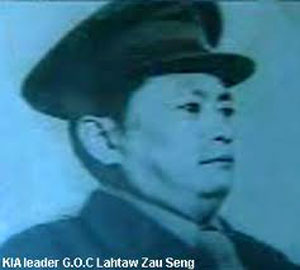In the midst of pressure from the Burmese military junta to toe its line on the contentious Border Guard Force issue, the ethnic Kachin rebel group, Kachin Independence Organization (KIO) commemorated...
In the midst of pressure from the Burmese military junta to toe its line on the contentious Border Guard Force issue, the ethnic Kachin rebel group, Kachin Independence Organization (KIO) commemorated its National Martyr’s Day today with hundreds attending in its capital Laiza in Kachin State, northern Burma.
 The ceremony was held with pomp and grandeur before noon in the public hall, known as Sinpraw Majoi Gawknu. Over a thousand attendants including civilians and men and women personnel of KIO honoured their fallen leaders and comrades.
The ceremony was held with pomp and grandeur before noon in the public hall, known as Sinpraw Majoi Gawknu. Over a thousand attendants including civilians and men and women personnel of KIO honoured their fallen leaders and comrades.
The reasons for commemorating Martyr’s Day and the sacrifice of so many were explained for hours by Salang kaba Doi Pyi Sa, deputy in-charge of KIO’s civil administration, also called the Department of General Administration (DGA), said participants.
After the ceremony, Salang kaba Doi Pyi Sa told Kachin News Group, “The commemoration was observed for the fallen KIO/KIA leaders and personnel as well as civilians, who died fighting for the KIO/KIA revolution”.
Doi Pyi Sa added, many KIO/KIA leaders, personnel and civilians were killed in civil wars as well as infighting in the KIO/KIA fold due to misunderstanding and reasons of inexperience on how to go about a revolution.
Two KIA soldiers--- Clerk Sergeant Galau Zau Lum and Corporal Lamung La were killed in the first battle with the Burmese Army in Nam Maw village in Loi Dau area, Northeast Shan State on May 18, 1961 after the KIA (the armed-wing of KIO) was formed on February 5, the same year, the KIA’s war history says.
Before being observed as a public ceremony, the Martyr’s Day was held at the Alen Bum military stronghold in Laiza by KIA troops, where no civilian was allowed to attend, said KIA sources.
The National Martyr’s Day marks the day the first KIO/KIA supreme leader Lahtaw Zau Seng was assassinated on the Thai-Burma border on August 10, 1975 by KIA officer Maran Seng Tu, who was alleged to be a spy of the Burmese junta.
Every year, the Martyr’s Day is held in KIO territories in Kachin State and Northeast Shan State after the official declaration on February 5, 2004 by the Kachin Independence Council (KIC) under KIO.
The KIO is one of the strongest ethnic armed groups in military-ruled Burma. It has over 20,000 troops including uniformed and non-uniformed ones in Kachin State and Northeast Shan State.
In a prolonged standoff, it foiled the plan of the junta led by Snr-Gen Than Shwe of disarming it in the name of transforming the KIA to the Burmese Army-controlled BGF in April. It is now gearing up for a fresh civil war with the junta’s army.
The KIO has proposed to the junta to start a political dialogue immediately or after the new government comes to power after the elections later this year, said KIO officials in Laiza.


